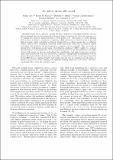An optical lattice with sound
Abstract
Quantized sound waves—phonons—govern the elastic response of crystalline materials, and also play an integral part in determining their thermodynamic properties and electrical response (for example, by binding electrons into superconducting Cooper pairs). The physics of lattice phonons and elasticity is absent in simulators of quantum solids constructed of neutral atoms in periodic light potentials: unlike real solids, traditional optical lattices are silent because they are infinitely stiff. Optical-lattice realizations of crystals therefore lack some of the central dynamical degrees of freedom that determine the low-temperature properties of real materials. Here, we create an optical lattice with phonon modes using a Bose–Einstein condensate (BEC) coupled to a confocal optical resonator. Playing the role of an active quantum gas microscope, the multimode cavity QED system both images the phonons and induces the crystallization that supports phonons via short-range, photon-mediated atom–atom interactions. Dynamical susceptibility measurements reveal the phonon dispersion relation, showing that these collective excitations exhibit a sound speed dependent on the BEC–photon coupling strength. Our results pave the way for exploring the rich physics of elasticity in quantum solids, ranging from quantum melting transitions to exotic ‘fractonic’ topological defects in the quantum regime.
Citation
Guo , Y , Kroeze , R M , Marsh , B P , Gopalakrishnan , S , Keeling , J & Lev , B L 2021 , ' An optical lattice with sound ' , Nature , vol. 599 , no. 7884 , pp. 211-215 . https://doi.org/10.1038/s41586-021-03945-x
Publication
Nature
Status
Peer reviewed
ISSN
0028-0836Type
Journal article
Description
Funding: We acknowledge funding support from the Army Research Office. Y.G. and B.M. acknowledge funding from the Stanford Q-FARM Graduate Student Fellowship and the NSF Graduate Research Fellowship, respectively. S.G. acknowledges support from NSF Grant No. DMR-1653271.Collections
Items in the St Andrews Research Repository are protected by copyright, with all rights reserved, unless otherwise indicated.

